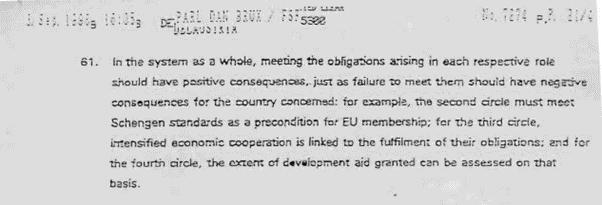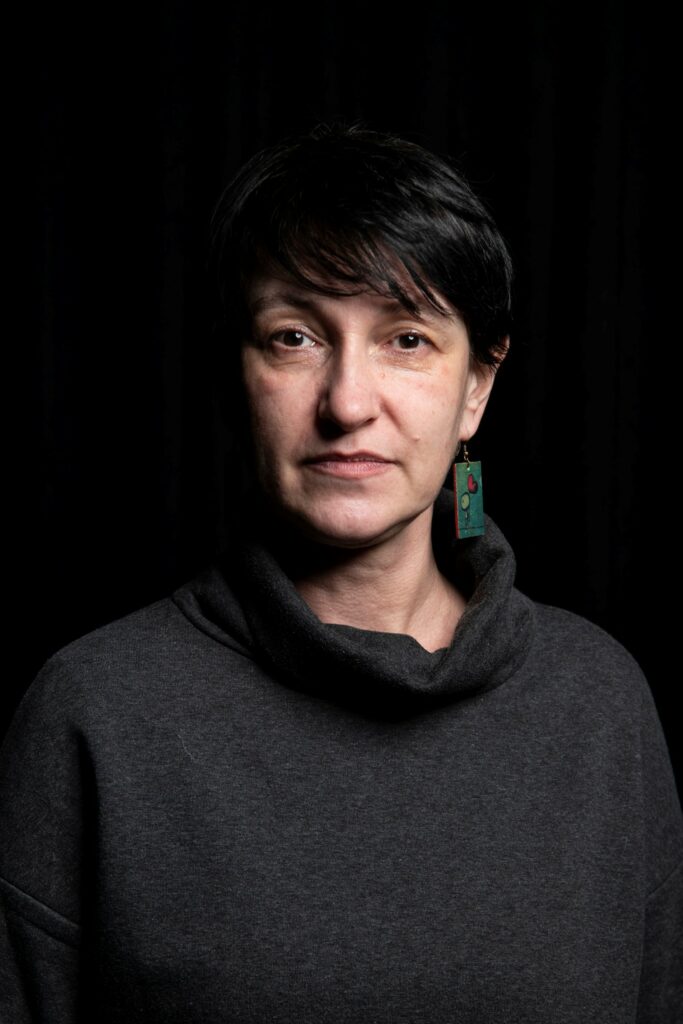
On the 28th of September 2020, Ayoub N. and six of his friends were chain pushed back from Austria to Slovenia, Croatia, and eventually back to Bosnia and Herzegovina (BiH), from where Ayoub had begun his journey to Austria a few weeks earlier. Ayoub, like many others, had been stuck for years in between the EU member states, in the Balkans, and this was just another attempt to reach the Schengen Zone. He continued trying even after this push-back. In July 2022, Ayoub was still stuck inside the Balkan Circuit (Stojić Mitrović and Vilenica 2019), a region of transit with many loops, within which movement is circular, going forward and backwards because of border violence.
Exactly one year after Ayoub and his group of friends experienced the chain push-back, Austrian Interior Minister, Karl Nehammer, finished his trip to Kosovo, Albania, and Montenegro meant to coordinate joint frameworks for fighting what he calls illegal migration, terrorism, and organized crime. During the trip, he announced that a “Return Conference” would take place a few months later in Vienna. The gathering in February 2022 brought together high-ranking officials from more than 22 countries, including representatives of EU agencies and think tanks. The main focus of the event was supporting Western Balkan[1] states with effective deportation practices through the newly established “Joint Coordination Platform against irregular migration.” BiH was mentioned as one of the platform’s main partners, and during the press conference organized after the event BiH Security Minister Selmo Cikotić stated that “With the support of the EU and some proactive partners, like Austria, we could move from a crisis situation to migration management.”
It is not known to the public how the “return mechanisms” discussed would materialize and on what legal grounds the return of people would take place. In 2021, a parliamentary request for information focused specifically on Austria’s plans to return people to the Western Balkans, while another asked details about the role of BiH. In response to the queries, the interior minister emphasized that Austria is “only” providing good practice, expertise, and training, while partner countries can state their specific needs and are, in the end, responsible for ensuring that the human rights of those concerned will be upheld. This is a common rhetorical practice in the context of EU border externalization policies, with EU countries only providing knowledge and equipment, while “accession” countries in the Balkans have to fulfil the dark side of Europeanization.
Austria took over a key role in building up a network of multilateral stakeholders that enables the fortification of Europe on diplomatic and informal levels, while states and locations near and far from Central Europe face the consequences of these policies; BiH is one example.
Lobbying for Externalization

In July 1998, Austria took over the EU presidency. As its first intervention on the issue of EU-migration policy, it introduced the Strategy Document on Immigration and Asylum Policies, which was sent to the European Council for further discussion. In this document, Austria advocated for a unified approach to migration in the Schengen area, which at that moment comprised 15 countries. It proposed the “Europeanization of migration policy,” while describing the existing approach and structures dealing with migration as “relatively clumsy.” The document called for more cooperation with “third states” in exchange for economic and other benefits. The Strategy envisaged that “Fortress Europe” should be replaced by the “concentric circles of the migration policy,” which included EU neighboring countries. Further, the neighboring partners “should be gradually linked into a similar system” that would eventually be similar to the “first circle,” meaning the EU member states. As for “transit countries,” the main approach would be to “eliminate push factors” in them. The Strategy called for the “tightening of the pre-accession strategy… as far as migration policies are concerned.” In addition, it stressed the need for agreements with third countries that would allow the return of people whose asylum applications were rejected, as well as the introduction of policies that would deter migration in general. The paper also argued that the Geneva Convention was outdated and that individual rights should be replaced with “political offers” of EU membership, or other types of cooperation.
By the end of the year, this proposal had been amended twice, but in the end it was rejected. A number of non-governmental organizations, including the International Federation for Human Rights, condemned the document on account of its harsh language and the restrictive measures proposed. Even though it was never adopted, the document remains a guideline, and some of its measures were put in place, especially in Austria. Along with several Balkan neighboring countries, Austria became more involved in security-related questions in the region, establishing various organizations and groups that are visibly active in the field, including the Salzburg Forum as one key intergovernmental group. Since the early 1990s, the forum functioned as a lobbying group, not only within the framework of the EU and on a regional level between its partners, but also on an often invisible level that reaches far beyond the EU. Austria played a key role in establishing the forum and is also one of its leading members. While the forum did not always achieve its strategic goals (Müller 2016, 28), it became a testing ground for fueling anti-Muslim and anti-migrant sentiments in Europe, and spearheaded plans for the dark future of EU border externalization policies. The multilateral cooperation within the Forum was based on debate, dialogue, exchange of ideas, and strategic planning; the establishment of its operative tool, the Joint Coordination Platform, is another step in cementing the externalization of border management to the Balkans.
Coordinating “Migration Management”
The Joint Coordination Platform (JCP) is a network that coordinates political and strategic intervention outside the Schengen Area, monitoring and controlling the EU’s external borders, as well as actions in third countries. Although it was already in the planning for several years, the JCP was inaugurated in Vienna after the Return Conference in February 2022. The JCP office is led by former Frontex Vice-President Berndt Körner and by lawyer Bohumil Hnidek,[2] and will provide a hinge function for Frontex operations in the Balkans (Monroy 2022). As the Frontex agency is not allowed to organize deportations to third countries, in the future it may support deportations from different EU countries to the Balkans, while the JCP would coordinate and monitor the rest of the “local” operations. In September 2022, the first deportations from Bosnia to Morocco with the support of the JCP already took place.
The investigative journalist Matthias Monroy further links the Vienna-based think tank ICMPD, led by former Austrian Vice-Chancellor Michael Spindelegger (ÖVP), to the operational implementation of regional return mechanisms to the Balkans. As early as 2020, the JCP started training police officers from BiH for conducting deportations. The training of 50 “return specialists” was recently described by Austrian Interior Minister Karner: “We help with training, impart standards, but that doesn’t change the responsibility that remains in the respective countries. It is about observing all international standards.”
To understand ICMPD’s practices on the ground, it is worth reviewing the project descriptions of its Western Balkans and Turkey office in recent years. The long-standing partner of the Salzburg Forum implements migration management, border management, and capacity building in the Balkans, for example by providing the border police in Kosovo[3] with technical and biometric equipment to register people on the move; and supporting the border police in Albania[4] with equipment for land border surveillance and maritime border surveillance and control. Capacity building in Albania means in particular providing patrol boats and surveillance vehicles. The regional capacity building projects further cover information campaigns for people in Afghanistan, Iraq, and people on the move in the Western Balkans.[5] Labelled as protection and support for migrants, ICMPD invests in the enhancement of migrant information systems[6] for authorities in BiH to implement entry control, registration, and data collection mechanisms. The “electronic biometric residence permit cards,” which should be made available through such projects, point not only to the on-ground preparation but also to the implementation of what investigative journalists call “extra-European Dublin.” This includes for example “Balkandac,” a fingerprint database in the Balkans that would allow countries to deport third-country nationals to countries with readmission agreements before entering the EU Schengen area.
It is important to highlight that ICMPD has entered the Joint Coordination Platform with years of experience in implementing EU border externalization projects in Africa and the Middle East (Naceur 2021).
Another active regional partner of the Joint Coordination Platform is Hilfswerk International. Next to the 1 million Euro in Austrian Development Aid that was used as an emergency relief fund through IOM in BiH in 2021, the Upper Austrian Federal Government donated 100,000 Euro to support the construction of a water system in the Lipa camp.[7] The project was implemented by Hilfswerk International, which has been working in the Balkans and especially in BiH as a humanitarian aid organization since 1996. While the organization covers a broad range of services in BiH, it recently joined the niche of network and capacity building in the field of “migration management” in BiH, Serbia, North Macedonia, and Montenegro.
Hilfswerk International has joined the field of migration management in Bosnia and Herzegovina as a player that can offer extensive experience on the ground. Considering the top-down and dysfunctional approach implemented by IOM in the region, Hilfswerk International is an organization that is closely linked to Austria-based actors and accessible for unbureaucratic and, according to its managing director, pragmatic solutions. As Regional Director Jašarević stated in an interview about their most recent project:
… we all know, and it is not a secret, that the EU does not want migrants on their territory. And what now? Should we leave them here to suffer or to disappear? It’s not possible.
They [the JCP] can use our infrastructure here if needed, but they also organize some events themselves. They are connecting donors and infrastructure. They know what is going on at a much deeper level than we do. And we are happy to contribute. They are working very hard as far as I know. Very few people and very big plans, but very capable people. I think it will be more visible this year. But it has only just started.[8]
Balkan Route: better coordination with Austrian aid
Even at the end of the 1990s, Austria’s political landscape paved the way for defining the Western Balkans as a strategic buffer zone for Europe’s increasingly restrictive migration and asylum policies. What has been drafted as a strategy to contain migration in “concentric circles” has since developed into the full-scale implementation of land and sea border zones that legitimate legislation, control, tracking, management of, and violence against people moving in circuits while trying to reach the EU Schengen zone.
Our study can be used as a tool to further investigate Austrian-based and Austrian-initiated organizations, security corporations, and individual actors that are heavily involved in violent EU border externalization from Vienna to Sarajevo and beyond.
The full study can be accessed here.
References:
Müller, Patrick. 2016. “Europeanization and regional cooperation initiatives: Austria’s participation in the Salzburg Forum and in Central European Defence Cooperation.” Österreichische Zeitschrift für Politikwissenschaft 45, no. 2: 24-34.
Stojić Mitrović, Marta, and Ana Vilenica. 2019. “Enforcing
and disrupting circular movement in an EU
Borderscape: housingscaping in Serbia.” Citizenship Studies 23, no. 6: 540-55.
Stojić Mitrović, Marta, Nidzara Ahmetašević, Barbara Beznec, and Andrej Kurnik. 2020. The Dark Sides of Europeanisation: Serbia, Bosnia and Herzegovina, and the European Border Regime. Belgrade: Rosa-Luxemburg Stiftung Southeast Europe; and Ljubljana: Inštitut Časopis za kritiko znanosti. https://rosalux.rs/wp-content/uploads/2022/04/169_the-dark-side-of-europeanisation-_vladan_jeremic_and_wenke_christoph_rls_and_ickz_2020.pdf.
[1] The authors only use the term Western Balkans in relation to the process of EU border externalization and accession plans of Albania, BiH, Kosovo, Montenegro, North Macedonia, and Serbia. See Stojić Mitrović et al. 2020, 20-22.
[2] Bohumil Hnidek is a lawyer and the former Director for International Cooperation and EU Affairs to the Ministry of interior of the Czech Republic.
[3] MIK: Manage increased influx of migrants in Kosovo, April, March 2021 (Fact Sheet ICMPD, 4).
[4] EU4SAVEALB: EU Support for the Effective Management of Green and Blue Borders in Albania, February 2019-April 2022 (Fact Sheet ICMPD, 7-8).
[5] IKAM: Information and capacity building on asylum, legal and irregular migration in Afghanistan, Iraq and the Western Balkans, March 2021-March 2022 (ICMPD Fact Sheet, 9).
[6] MiS BiH: Enhancement of Migration Information System for Strengthening Migration, Asylum and Border Management in Bosnia and Herzegovina, November 2021-March 2023 (ICMPD Fact Sheet, 9-10).
[7] In mid-June 2022, people living in Lipa reached out to local volunteers in BiH to inform them that for a week they did not have running water. At that moment, the temperatures were over 40 degrees. Even though less than 400 people were in the camp (capacity is 1,500), people were crammed in containers (six in each) with one small fan, and were receiving a gallon of water per person a day. Every day, one cistern was used. According to the testimony, there was no water in the bathrooms and toilets, either. After the information was published on social media, people in the camp told local volunteers that the employees in the camp threatened some of the residents, warning them that they cannot talk about the camp and saying that if they did not like the place they could leave.
[8] Interview Suzana Jašarević online, 15 March 2022.

Nidžara Ahmetašević is a freelance journalist and an independent researcher. She is living and working in Sarajevo. Photo by: Ferdi Limani

Klaudia Wieser is a PhD candidate at the University of Vienna and a founding member of Push-Back Alarm Austria.

One reply on “At the heart of Fortress Europe: A new study about Austria’s role in border externalization policies in the Balkans”
[…] Tekst Nidžare Ahmetašević i Klaudije Wieser – At the heart of Fortress Europe: A new study about Austria’s role in border externalization policies in the Balkans; […]